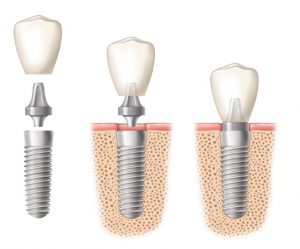Header logo
header top contact widget
grinding or clenching
Use Your ‘Sheltering In’ Time To Expand Dental Knowledge
Posted on Mar 25, 2020 by William J. Claiborne, DDS MS
Whether by requirement or feeling the need to reduce susceptibility to COVID-19, many people in the U.S. are “sheltering in.” I think of how this is likened to the term “hunker down” when hurricanes or tornadoes are present. However, “sheltering in” is requiring lengthy periods of being housebound.
Although that may seem depressing, people all over the world are getting rather creative at how they’re managing. With the internet, we are able to stay connected, share jokes and encouragement, and relay tips and important info to one another.
You may have seen music being performed on the balconies of homes in Italy and by policemen in the streets of Germany. People who are close to hospitals are applauding the caregivers as they enter and leave.
There are many uplifting things occurring in the midst of this trying time. I hope you are using your time positively and keeping your mind and body active. These will help you get through this time with greater resilience and a ready-to-go attitude once our country is getting back to normal.
In the meantime, I thought I’d share some terms used in dentistry you may find helpful once dental offices are back up and operating on a normal schedule. Some include:
• Perio – This is actually a shortened version of ‘periodontal,’ which describes the pink, soft tissues in the mouth. Your periodontal health relates to your gum tissues, primarily.
• Buccal – This is dental lingo that refers to the front sides of teeth or gum tissues on the side of the cheeks.
• Lingual – This term describes the sides of teeth facing the tongue. A way to remember this is to think of the tongue “lingering” in the mouth and the sides of teeth and tissues surrounding it.
• Prophy – A prophy is actually a dental cleaning, which is meant to support the gum tissues by removing plaque and tartar that has accumulated on teeth since your last cleaning. A prophy is recommended every six months to help manage this buildup. When too much tartar (or calculus) accumulate on teeth, it can cause inflammation that goes deeper into gum tissues. Once this inflammation is active, a prophy likely won’t remove the extent of the damage nor halt its progress. When this occurs, the typical recommendation is a…
• Scaling & Root Planing – This procedure is a deep cleaning that goes beneath the surface of gum tissues and teeth. This is typically performed while the gums are numbed. Because some areas are time-consuming to clean, scaling and root planing is often performed in…
• Quadrants – A ‘quad,’ if you remember your high school math lessons, is a fourth of something. In the mouth, your quadrants are the top right side of the mouth, top left, lower right and lower left. If you use one of the newer electronic toothbrushes, you may get a ‘beep’ when it’s time to move from one quadrant to another. This allows you to give sufficient attention to each quadrant in the mouth so you’re doing a thorough job at each brushing.
• Pits and Fissures – Natural teeth may seem smooth. From a dentist’s view, each tooth has a distinct surface. This is especially true for teeth with larger “tops.” The grooves in these teeth are ideal hiding spots for bacteria since a toothbrush has a more difficult time sweeping them away. This is why some people have sealants applied, especially children who are still learning good brushing techniques.
• Bruxing – Simply, bruxing is the grinding or clenching of teeth, typically during sleep. Although tooth grinding is often blamed on stress or anxiety, it can also occur when teeth are misaligned (crooked).
Although we try not to use terminology that is unfamiliar to patients, we occasionally slip. Hopefully, you will speak up and question these so you stay fully informed as you make decisions that are best for your smile.
While your schedule may be anything but ‘normal’ during this period, we hope you’ll stay committed to your routine of twice daily brushing, flossing daily, limiting sugar and snacking, and drinking plenty of water to keep the mouth moist.
We look forward to “life as we know it” soon! Let’s pray this is short-lived and our nation is restored to a healthy, active country – with even greater appreciation for these gifts!
Don’t Let Misaligned Teeth Lead To Tooth Loss.
Posted on Feb 25, 2019 by William J. Claiborne, DDS MS
As a periodontist, I have specialized skills in treating all stages of gum disease (known as periodontal disease, or simply “perio” by some). I also have advanced training in the diagnosis and placement of dental implants.
Although my specialty does not cover the advanced training an orthodontist has in bite alignment, my dental education absolutely covered the benefits of having proper “occlusion.” It also covered the repercussions of NOT having a bite that is properly balanced.
Just as an orthodontist can spot telltale signs of gum inflammation, I (along with general dentists and most dental specialists) can see indications of teeth that are not working in unison — even at times when these teeth appear to be “straight.”
While the nation’s number one cause of adult tooth loss is gum disease, having a misaligned bite function (or “malocclusion”) can lead to tooth loss in ways you may not have realized.
For example, during chewing, the upper teeth and lower teeth are designed to work harmoniously together to grind food down for swallowing and digesting. When an upper tooth does not interact smoothly with one below it (or vice versa), a tooth can become chipped, broken or fractured.
When damage to a tooth occurs, it must be quickly repaired before oral bacteria can penetrate tooth structures. Without the protection of enamel, oral bacteria can cause tooth decay and gum disease.
A fracture in a tooth can expand over time, leading to a crack that loosens an entire segment of a tooth. These areas must also be repaired before the tooth is subjected to oral bacteria. This typically requires a crown (or “cap”) that is placed over the top portion of the tooth.
However, a crack in a tooth that extends into the gum tissues typically means the tooth must be removed. If a portion of the tooth breaks “just below” the gum tissue, the tooth can sometimes be saved by a procedure we do called a “crown lengthening.” This is often known as a gingivectomy and is performed to remove excess gum tissues.
A gingivectomy procedure exposes more of the natural tooth so a crown can be placed over the tooth to preserve its remaining structure. (For people who have a “gummy smile,” this is performed, also, to reduce the amount of gum tissue that arches over teeth most visible in a smile.)
Another hazard of bite misalignment relates to dental implants. The overall success rate of dental implants is very high, nearly 98 percent by some estimates (when properly selected, placed and maintained). However, when a newly-placed implant is subjected to the grinding forces of TMJ disorders, its risks for success are much lower.
People are often surprised to learn that they clench and/or grind their teeth at night – primarily due to bite misalignment. When a bite is “off,” the jaw joints can become strained and inflamed. During sleep, the upper and lower jaws go on a subconscious quest of sorts, searching to find a comfortable position that eliminates the strain.
The forces behind some clenching are enough to crack open a walnut. Imagine a newly placed implant that is dependent upon the jaw bones to “heal” it into this firm foundation. When the area of bone around an implant is subjected to night after night of disruption, the implant is against the odds of becoming fully embedded in supporting bone.
Here’s an example: Let’s say you use a screwdriver to firmly anchor a screw into a solid block of wood. However, every day, you use a pair of pliers to grasp the screw head and wriggle it back and forth. Obviously, it wouldn’t take long for the wood surrounding the length of the screw to wear down from the friction of the screw’s motion, even slight as it may seem. Eventually, the screw could be easily moved back and forth and would no longer serve as a dependable base of support.
It’s not unusual for more than one dental specialist to work with another to provide a patient with the combined skills needed in particular cases. I frequently work with other dental specialists and general dentists in a “team treatment” capacity in order to give patients optimal outcomes.
When we place an implant, our goal is for each patient to enjoy its benefits for the remainder of their life. Bite misalignment can jeopardize this. And, if you have all your natural teeth now, be sure to protect them by keeping your gums healthy and ensuring your bite is as well.
After all, every dental professional is on your team when it comes to enjoying confident smiles for a lifetime!
If you’ve noticed indications of gum disease (tender gums that bleed when brushing, for example) or have experienced tooth loss (or fear you are facing it), take charge of your smile now. Call 828-274-9440 to schedule a thorough examination.
Ways To Have A Successful Outcome With Dental Implants
Posted on Jul 16, 2018 by William J. Claiborne, DDS MS
For many individuals who wish to replace one or more missing teeth, dental implants have become the leading preference. Dental implants restore the look, feel, and function like that of natural teeth. They also help to prevent bone shrinkage that occurs when tooth roots are no longer present in the jaw bone.
A periodontist has advanced training in the diagnosis and placement of dental implants. He or she can help you enjoy a higher potential for dental implant treatment that lasts your lifetime. There are a number of reasons you should strongly consider having a periodontal specialist involved in your treatment.
SELECTION OF IMPLANTS – Dental implants come in a wide array of shapes and sizes. Each system is designed to accommodate certain needs and preferences. For example, some implants are designed to support a full arch of teeth while others can be placed in areas where a great deal of bone loss has occurred. The selection of the implant type that is appropriate for your needs and goals requires a unique understanding of all implant types. That is, a periodontist can select the type that will work best for you rather than go with the one or two in which they have received training.
PLACEMENT OF IMPLANTS – In addition to selecting the best type for your needs, proper placement of implants has a great deal to do with having a successful outcome. When an implant that is too long, for instance, is placed in bone that is too shallow, it can have future repercussions that may require its removal. This could occur when a lower implant is placed too close to a nerve that runs horizontal through the jaw bone (mandible). Or, when an upper implant is placed in shallow bone, it can work its way into the sinus cavity. A periodontal specialist considers intricate factors that can effect your potential for success.
STRUCTURAL ISSUES – In addition to the factors involved with bone loss, other issues can ‘make or break’ having a successful treatment outcome with dental implants. For example, for people who have bite misalignment or TMJ disorders, they may be grinding or clenching their teeth during sleep – often unknowingly. Telltale signs of ‘bruxing’ including remaining, natural teeth that are chipped or worn. These forces have been measured to that enough to crack a walnut! When dental implants endure these forces, especially during their ‘healing’ phase, there is greater risk for implant failure. A periodontist considers these issues prior to your treatment, helping you to bypass problems that can result in eventual removal.
INDIVIDUALIZED TREATMENT CONSIDERATIONS – Our goal is to help you get the most from your dental implants. When there are individual habits or preferences that can complicate success, we work with each patient to help them enjoy their dental implants for a lifetime. For smokers, we advise ways to support saliva flow and minimize oral bacteria levels. For people who take certain medications that can interfere with oral moisture, we recommend methods to keep the mouth properly hydrated. And so on. We want to make sure your care is individualized so your potential for implant success is high!
Unfortunately, I have seen a number of patients over the years who have had implants that were improperly placed or chosen. It is a significant loss for the patient when they have to have these implants removed and start all over. Like any procedure, you want your treatment time and investment to be successful and a pleasant experience. We do, too!
If you’ve considered dental implants to replace missing teeth, let’s discuss how a periodontal dental office can enhance your potential to enjoy confident smiles and chewing comfort for your lifetime! Call 828-274-9440 to schedule an appointment.
Is Insurance Coverage Ruling Decisions For A Confident Smile?
Posted on May 22, 2018 by William J. Claiborne, DDS MS
I think we’d all agree that having insurance coverage today is necessary, albeit rather costly. For those who shell out hundreds of dollars each month (or more, based on deductibles and dependents), it can be an investment that gives peace of mind and strains our budgets at the same time. I have friends who pay MORE for health insurance coverage than their monthly home mortgage. Ouch!
Regardless of the type of insurance coverage you have, using its benefits to the max is a yearly goal. Some people have Health Savings Accounts (HSA) to help buffer certain non-covered, health-related expenses. However, because of the monthly costs, it is to no surprise that we monitor treatment accepted to keep our out-of-pocket within covered levels.
Dental insurance was developed to give people some help for typical annual expenses. For many, this includes twice-a-year dental exams and cleanings. Some policies include assistance for an annual crown or filling, and some coverage for periodontal (gum) therapy to treat gum disease. Higher end policies may cover portions of orthodontic treatment (braces) or oral appliances to treat TMJ (jaw joint) disorder.
For smile-conscious individuals, these benefits sound terrific. For an affordable monthly fee, the annual costs for dental care are more budget friendly. But, are they smile friendly?
The ‘catch’ for policy holders occurs in what these for-profit insurance companies deem coverage-worthy. What is appropriate for a patient’s long term oral health versus what is approved for coverage may be very different. This has become a real dilemma for many dentists and dental specialists.
For example, when I consult with a patient who is missing several teeth, I recommend dental implants. My recommendation is based upon what will provide the patient with a lifelong solution for missing teeth as well as other benefits.
I look at a dental implant as the ideal in tooth replacement, since it is held in the jaw bone just as natural tooth roots. An implant restores the dependable foundation necessary for biting and chewing, enabling the patient to eat a healthy diet and chew foods comfortably, which supports the digestive system and overall health.
Yet, dental implants are a more expensive option (initially) than crown-&-bridge combinations, dentures, or partials. So, guess what is often deemed as ‘elective’ by insurance companies? Right! But, is protecting your overall health and smiling confidence elective to YOU?
What it comes down to is, essentially, how we perceive insurance coverage. While major medical insurance gives us peace of mind should we experience a health challenge that would otherwise drain us financially, most dental insurance coverages are different.
Dental insurance, for the most part with most policies, is set up to provide ‘support’ in maintaining a healthy mouth. For people who already have good oral health and are able to tend to it sufficiently between regular dental checkups, this is fine. However, for most American adults, tooth repair, tooth loss and gum problems are a fact of life, particularly as we age.
For most of us, the decisions we make today will affect us in the years to come. When it comes to your oral health, don’t let your long-term oral wellness, the longevity of your teeth, the comfort of eating, or the confidence of smiling and laughter be dictated by what insurance coverage allows.
If you trust your dentist and others involved to help guide you towards good oral health and maintaining your smile, consider the recommendations made and ask questions. Be an informed consumer. But, most importantly, be sure to make decisions that are in your best interests rather than that which a for-profit insurance company deems worthy for your smile.
You may be interested that the five largest insurance companies in the U.S. (Aetna, Anthem, Cigna, Humana, United Health Group) enjoyed $4.5 billion in NET earnings in just the first quarter of 2017. That’s BILLION, with a B! (https://www.axios.com/profits-are-booming-at-health-insurance-companies-1513302495-18f3710a-c0b4-4ce3-8b7f-894a755e6679.html) And, that’s just a 3-month period!
Healthcare is a dilemma our nation will struggle with for years to come. In the meantime, put YOUR needs first and take charge of YOUR well-being by finding dental caregivers you feel will guide you best to a lifetime of confident, comfortable, and healthy smiles – for a lifetime!
If you don’t have regular dental care and would like recommendations, feel free to contact us at 828-274-9440. We work with exceptional general dentists in Western North Carolina and will be proud to connect you. Or, feel free to begin with a thorough periodontal exam here. We will make recommendations based upon your unique needs and goals.
Recent Posts
Categories
Archives
- September 2024
- August 2024
- July 2024
- June 2024
- May 2024
- April 2024
- March 2024
- February 2024
- January 2024
- December 2023
- November 2023
- October 2023
- September 2023
- August 2023
- July 2023
- June 2023
- May 2023
- April 2023
- March 2023
- February 2023
- January 2023
- December 2022
- November 2022
- October 2022
- September 2022
- August 2022
- July 2022
- June 2022
- May 2022
- April 2022
- March 2022
- February 2022
- January 2022
- December 2021
- November 2021
- October 2021
- September 2021
- August 2021
- July 2021
- June 2021
- May 2021
- April 2021
- March 2021
- February 2021
- January 2021
- December 2020
- November 2020
- October 2020
- September 2020
- August 2020
- July 2020
- June 2020
- May 2020
- April 2020
- March 2020
- February 2020
- January 2020
- December 2019
- November 2019
- October 2019
- September 2019
- August 2019
- July 2019
- June 2019
- May 2019
- April 2019
- March 2019
- February 2019
- January 2019
- December 2018
- November 2018
- October 2018
- September 2018
- August 2018
- July 2018
- June 2018
- May 2018
- April 2018
- March 2018
- February 2018
- January 2018
- December 2017
- November 2017
- October 2017
- September 2017
- August 2017
- July 2017
- June 2017
- May 2017
- April 2017
- March 2017
- February 2017
- January 2017
- December 2016
- November 2016
- October 2016
- September 2016
- August 2016
- July 2016
- June 2016
- May 2016
- April 2016
- March 2016
- February 2016
- January 2016
- December 2015
- November 2015
- October 2015
- September 2015
- August 2015
- July 2015
- June 2015
- May 2015
- April 2015
- March 2015
- February 2015
- January 2015
- December 2014
- November 2014
- October 2014
- September 2014
- August 2014
- July 2014
- June 2014
- May 2014
- April 2014
- March 2014
- February 2014
- January 2014
- December 2013
- November 2013
- October 2013
- September 2013
- August 2013
- July 2013
- June 2013
- May 2013
- April 2013
- March 2013
- February 2013
- January 2013
- December 2012
- November 2012
- October 2012
- September 2012
- August 2012
- July 2012
- June 2012


